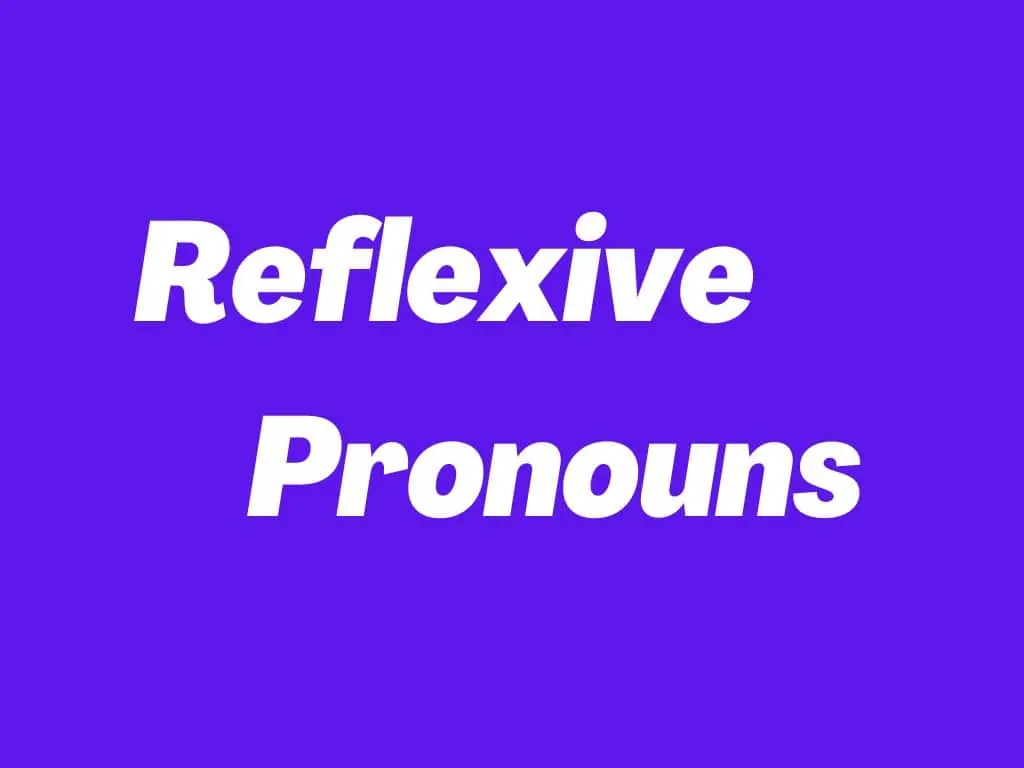

Reflexive pronouns are a type of pronoun that refers back to the subject of the sentence. They are commonly used in English grammar and can be a great tool to add clarity and precision to your writing. In this blog post, we will cover everything you need to know about reflexive pronouns - what they are, different types, examples, grammar rules, benefits of using them, common mistakes to avoid, strategies to remember them, and ways to practice them.
Reflexive pronouns are words that refer back to the subject of the sentence. For example, in the sentence "I see myself in the mirror", the reflexive pronoun "myself" is used to refer back to the subject of the sentence, "I". Reflexive pronouns are important tools for precision and clarity in writing.
There are nine reflexive pronouns in English: myself, ourselves, yourself, yourselves, themselves, himself, herself, itself, and oneself. These pronouns are used to emphasize the subject of the sentence and add clarity. They can be used in place of another pronoun to avoid repetition or to add emphasis.
|
Singular: |
myself |
yourself |
|
himself |
herself |
itself |
|
oneself |
|
|
Plural: |
ourselves |
yourselves |
|
themselves |
|
|
There are three types of reflexive pronouns: intensive, emphatic, and reciprocal. Intensive pronouns are used to emphasize the subject of the sentence and add emphasis. For example, in the sentence "I myself am going to the store", the intensive reflexive pronoun "myself" is used to emphasize the subject "I". Emphatic reflexive pronouns are used to add emphasis to a statement. For example, in the sentence "I did it myself", the emphatic reflexive pronoun "myself" is used to emphasize the subject "I". Reciprocal reflexive pronouns are used to indicate mutual action between two or more people. For example, in the sentence "My friends and I exchanged gifts with each other", the reciprocal reflexive pronoun "each other" is used to indicate mutual action between "My friends" and "I".
Now that we've covered the types of reflexive pronouns, let's look at some examples.
Reflexive pronouns are an important part of English grammar, and there are a few rules to keep in mind when using them.
First, reflexive pronouns must match the subject in number and person. For example, if the subject is "he", then the reflexive pronoun must be "himself". If the subject is "we", then the reflexive pronoun must be "ourselves".
Second, reflexive pronouns can only be used when the subject and the object of the sentence are the same person or thing. For example, in the sentence "I see myself in the mirror", the subject "I" and the object "myself" are the same person.
Third, reflexive pronouns can only be used when the subject is a pronoun. For example, in the sentence "I see myself in the mirror", the subject is a pronoun ("I"). However, reflexive pronouns cannot be used when the subject is a noun. For example, in the sentence "The dog saw itself in the mirror", the subject is a noun ("dog"), and therefore a reflexive pronoun cannot be used.
There are many benefits to using reflexive pronouns in your writing. First, they can help to add clarity and precision to your writing. By using reflexive pronouns, you can avoid repetition or confusion by referring back to the subject of the sentence.
Second, reflexive pronouns can help to emphasize the subject of the sentence and add emphasis. For example, when used in an emphatic sentence, reflexive pronouns can make a statement more powerful and persuasive.
Finally, reflexive pronouns can help to add a personal touch to your writing. By using reflexive pronouns, you can make your writing more conversational and engaging.
Although reflexive pronouns are a great tool to add clarity and precision to your writing, they can also be misused. Here are some of the most common mistakes with reflexive pronouns.
First, reflexive pronouns must match the subject in number and person. For example, if the subject is "he", then the reflexive pronoun must be "himself". If the subject is "we", then the reflexive pronoun must be "ourselves". People often make the mistake of using reflexive pronouns that don't match the subject in number and person.
Second, reflexive pronouns can only be used when the subject and the object of the sentence are the same person or thing. For example, in the sentence "I see myself in the mirror", the subject "I" and the object "myself" are the same person. People often make the mistake of using reflexive pronouns when the subject and object are not the same.
Third, reflexive pronouns can only be used when the subject is a pronoun. For example, in the sentence "I see myself in the mirror", the subject is a pronoun ("I"). People often make the mistake of using a reflexive pronoun when the subject is a noun.
Now that we've gone over the rules and common mistakes for reflexive pronouns, let's look at some strategies to help you remember them.
First, remember that reflexive pronouns must match the subject in number and person. For example, if the subject is "he", then the reflexive pronoun must be "himself". If the subject is "we", then the reflexive pronoun must be "ourselves".
Second, remember that reflexive pronouns can only be used when the subject and the object of the sentence are the same person or thing. For example, in the sentence "I see myself in the mirror", the subject "I" and the object "myself" are the same person.
Third, remember that reflexive pronouns can only be used when the subject is a pronoun. For example, in the sentence "I see myself in the mirror", the subject is a pronoun ("I").
Finally, remember that reflexive pronouns are used to emphasize the subject and add clarity to your writing. By using reflexive pronouns, you can avoid repetition or confusion and make your writing more precise and engaging.
Now that we've gone over the rules and strategies for using reflexive pronouns, let's look at some ways to practice them.
First, try using reflexive pronouns in your everyday speech. For example, you could use reflexive pronouns when introducing yourself ("My name is Sarah, and I'm from Canada"), when talking about your hobbies ("I love to read books and watch movies by myself"), or when describing your experiences ("I've been to Italy twice, the first time with my family and the second time by myself").
Second, try writing sentences with reflexive pronouns. For example, you could write sentences such as "I see myself in the mirror", "My friends and I exchanged gifts with each other", or "I did it myself". This will help you to get used to using reflexive pronouns in your writing.
Third, try taking online quizzes or tests to practice your reflexive pronoun usage. There are many online quizzes and tests available that will help you to practice your reflexive pronoun usage.
Reflexive pronouns are an important part of English grammar, and they can be a great tool to add clarity and precision to your writing. In this article, we've covered everything you need to know about reflexive pronouns - what they are, the different types, examples, grammar rules, benefits of using them, common mistakes to avoid, strategies to remember them, and ways to practice them.
By following the rules and strategies outlined in this article, you can become a better writer and achieve clarity in your writing. So don't be afraid to use reflexive pronouns - they can be a great tool to add clarity and precision to your writing.
Data: December 22nd, 2022
 Rob
Rob